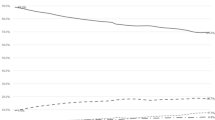Abstract
Households that include adult children may arise out of collective necessities, not just the needs or shortcomings of the adult child. Therefore living in the parental home does not necessarily preclude the transition to adulthood. An analysis of household income in the 1980 U.S. Census demonstrates that while parents on average contribute a larger share of household income than their adult child does, some parents and children share a need for joint living arrangements. The parental characteristics associated with such needs include an older householder, a female householder, and income close to or below the poverty line.
Similar content being viewed by others
References
Aldous, J. (1987). New views in the family life of the elderly and the near-elderly.Journal of Marriage and the Family, 49, 227–234.
Angel, R., & Tienda, M. (1982). Determinants of extended household structure: Cultural pattern or economic need.American Journal of Sociology, 37, 1360–1383.
Beresford, J., & Rivlin, A. (1966). Privacy, poverty, and old age.Demography, 3, 247–258.
Bianchi, S. (1987, August).Living at home: Young adults' living arrangements in the 1980s. Paper presented at the annual meeting of the American Sociological Association, Chicago.
Glick, P. (1977). Updating the life cycle of the family.Journal of Marriage and the Family, 39, 5–13.
Glick, P., & Lin, S. L. (1986). More young adults are living with their parents: Who are they?Journal of Marriage and the Family, 48, 107–112.
Goldscheider, C., & Goldscheider, F. (1987). Moving out and marriage: What do young adults expect?American Sociological Review, 52, 278–285.
Goldscheider, F., & DaVanzo, J. (1988).Pathways to independent living in early adulthood: Marriage, semiautonomy, and premarital residential independence (Working Paper Series 88-01). Providence, RI: Brown University, Population Studies and Training Center.
Goldscheider, F., & Goldscheider, C. (1989). Family structure and conflict: Nest-leaving expectations of young adults and their parents.Journal of Marriage and the Family, 51, 87–97.
Goldscheider, F., & LeBourdais, C. (1986). The decline in age at leaving home, 1920–1979.Sociology and Social Research, 70, 143–145.
Grigsby, J., & McGowan, J. (1986). Still in the nest: Adult children living with their parents.Sociology and Social Research, 70, 146–148.
Heer, D., Hodge, R., & Felson, M. (1985). The cluttered nest: Evidence that young adults are more likely to live at home now than in the recent past.Sociology and Social Research, 69, 436–441.
Hogan, D., & Astone, N. (1986). The transition to adulthood. In R. Turner & J. Short (Eds.),Annual Review of Sociology: Vol. 12, 1986 (pp.109–130).Palo Alto, CA:Annual Reviews Inc.
Kingson, E., Hirshorn, B., & Cornman, J. (1986).Ties that bind: The interdependence of generations. Washington, DC: Seven Locks Press.
Kobrin, F. (1976). The fall in household size and the rise of the primary individual in the United States.Demography, 13, 127–138.
Kobrin, F. (1981). Family extension and the elderly: Economic, demographic, and family life cycle factors.Journal of Gerontology, 36, 370–377.
Laslett, B. (1973). The family as a public and private institution: An historical perspective.Journal of Marriage and the Family, 35, 480–492.
Marini, M. (1984). Age and sequencing norms in the transition to adulthood.Social Forces, 63, 229–244.
Masnick, G., & Pitkin, J. (1983, April).The baby boom and the squeeze on multigenerational households. Paper presented at the annual meeting of the Population Association of America, Pittsburgh.
Menken, J. (1985). Age and fertility: How late can you wait?Demography, 22, 469–483.
Michael, R., Fuchs, V., & Scott, S. (1980). Changes in the propensity to live alone: 1950–1976.Demography, 17, 39–56.
Pampel, F. (1983). Changes in the propensity to live alone: Evidence from consecutive cross-sectional surveys, 1960–1976.Demography, 20, 433–447.
Parsons, T. (1949). The social structure of the family. In R. Anshen (Ed.),The family: Its function and destiny (pp. 173–201). New York: Harper and Brothers.
Rindfuss, R., Swicegood, C., & Rosenfeld, R. (1987). Disorder in the life course: How common and does it matter?American Sociological Review, 52, 785–801.
Rubin, L. (1976).Worlds of pain: Life in the working-class family. New York: Basic Books.
Schnaiberg, A., & Goldenberg, S. (1986, August).From empty nest to crowded nest: Some contradictions in the returning-young-adult syndrome. Paper presented at the annual meeting of the American Sociological Association, New York.
Shanas, E. (1980). Older people and their families: The new pioneers.Journal of Marriage and the Family, 42, 9–15.
Stack, C. (1974).All our kin: Strategies for survival in a Black community. New York: Harper Colophon.
Suitor, J., & Pillemer, K. (1987). The presence of adult children: A source of stress for elderly couples' marriages?Journal of Marriage and the Family, 49, 717–725.
Thornton, A., & Freedman, D. (1983).The changing American family (Population Bulletin 38, 4). Washington, DC: Population Reference Bureau.
U.S. Bureau of the Census. (1989).Marital status and living arrangements: March 1988 (Current Population Reports P-20, No. 433). Washington, DC: U.S. Government Printing Office.
Waite, L., Goldscheider, F., & Witsberger, C. (1986). Nonfamily living and the erosion of traditional family orientations among young adults.American Sociological Review, 51, 541–554.
Watkins, S., Menken, J., & Bongaarts, J. (1987). Demographic foundations of family change.American Sociological Review, 52, 346–358.
White, L., & Booth, A. (1985). The quality and stability of remarriages: The role of stepchildren.American Sociological Review, 50, 689–698.
Author information
Authors and Affiliations
Additional information
This is a revised version of a paper presented at the annual meeting of the American Sociological Association, New York, August, 1986. A post-doctoral training grant from the National Institute on Aging (1-T32-AG00151-01) carried out at the Population Studies Center, University of Michigan provided some of the support for this paper. Deborah Freedman, Barbara Hirshorn and Frances Goldscheider provided helpful comments; However they are not responsible for any errors.
Jill S. Grigsby is Associate Professor of Sociology, Pomona College, Claremont, CA91711. She received her Ph.D. from Princeton University and includes family living arrangements and population aging among her research interests.
Rights and permissions
About this article
Cite this article
Grigsby, J.S. Adult children in the parental household: Who benefits?. J Fam Econ Iss 10, 293–309 (1989). https://doi.org/10.1007/BF00986864
Issue Date:
DOI: https://doi.org/10.1007/BF00986864




